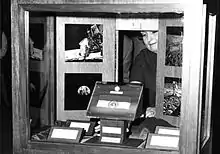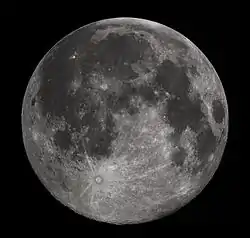Missouri lunar sample displays
The Missouri lunar sample displays are two commemorative plaques consisting of small fragments of Moon specimen brought back with the Apollo 11 and Apollo 17 lunar missions and given in the 1970s to the people of the state of Missouri by United States President Richard Nixon as goodwill gifts.[1][2]

March 17, 1970
Description
Apollo 11

The Missouri Apollo 11 lunar sample display commemorative podium style plaque consists of four "Moon rock" rice-size particle specimens that were collected by Apollo 11 astronauts Neil Armstrong and Buzz Aldrin in 1969 and a small Missouri state flag that was taken to the Moon and back on Apollo 11.[1]
The four "Moon rocks" weigh about 0.05 grams total and are encased in a clear plastic button the size of a coin which is mounted to a wooden board approximately one foot square on a small podium pedestal display. The small podium plaque display also has mounted on it a small Missouri state flag that had been taken to the Moon and back, which lies directly below the acrylic button with the "moon rocks". The small podium plaque display was given to the people of the state of Missouri as a gift by President Richard Nixon. Similar lunar sample displays were also distributed to all the other states of the United States and all the countries (at the time) of the world.[1]
Apollo 17

The Missouri Apollo 17 lunar sample display commemorative style plaque (10 by 14 inches) consists of one "Moon rock" particle specimen that was cut from lunar basalt 70017 and a Missouri state flag. The basalt 70017 was collected by Apollo 17 astronaut Harrison Schmitt on the Moon in 1972. Once lunar basalt 70017 was brought back to earth from the Moon, the basalt Moon rock was cut up into small fragments of approximately 1 gram. The specimen was encased in an acrylic ball and mounted on the wooden plaque along with the Missouri state flag which had been taken to the Moon and back by the crew of Apollo 17. The plaque was then distributed in 1973 by President Richard Nixon to the state of Missouri as he did that year to the other 49 states (the same as for the Apollo 11 plaque gifts). This was done as a goodwill gesture to promote peace and harmony.[2]
History
In May 2010, The Record of Hackensack, a newspaper in northern New Jersey, reported that Missouri's "goodwill Moon rock" was lost and its location was unknown. The Missouri State Museum claimed its "goodwill Moon rock", worth millions of dollars, was securely housed at the Missouri State Capitol. The newspaper's pictures of the "goodwill Moon rock" were shown to Joseph Gutheinz, a former special agent with NASA's Office of Inspector General and a self-appointed investigator on the Apollo lunar sample displays. When Gutheinz saw the pictures, he pointed out the problem: they were pictures of the Apollo 11 "goodwill Moon rocks", which technically are nothing more than dust or Moon soil. The pictures showed four grain-size pebbles housed in a clear acrylic button the size of an American half dollar. While these 0.05 gram pebbles or dust particles are sometimes referred to as "Moon rocks", they were not the single Apollo 17 "goodwill Moon rock" of 1.14 grams. Discovering the location of the Apollo 17 "goodwill Moon rock" later became a passion for the museum. After an in-depth search of its records, the museum discovered that it never received the Missouri Apollo 17 lunar sample display with its single "goodwill Moon rock" weighing 1.14 grams. The display had been given to then-Missouri Governor Kit Bond in 1973 as a gift to the people of the state of Missouri, but it never went any further than his office.[3][4][5]
The Missouri archives staff checked their old records and discovered nothing in Bond's papers about any "Moon rock". The Bond administration at the time didn't enter it into any inventory control system, because they thought of the Apollo 17 "goodwill Moon rock" as a novelty and of little importance. A value of $5 million to $10 million has since been placed on the "Moon rock", because no other crewed Moon landings have occurred since 1972 and no other Moon material has been obtained since then. In December 2010, Bond turned over the Missouri Apollo 17 lunar sample display to current Governor Jay Nixon, and Nixon passed it on to the Missouri State Museum. The Apollo 17 display with the single Apollo 17 "goodwill Moon rock" of 1.14 grams is now at the Missouri State Museum, the same place as the Apollo 11 "goodwill Moon rocks" of 0.05 grams.[6][7][8][9][10]
References
- Pearlman, Robert (1999–2012). "Where today are the Apollo 11 goodwill lunar sample displays?". collectspace.com. Retrieved November 2, 2012.
- Pearlman, Robert (1999–2012). "Where today are the Apollo 17 goodwill lunar sample displays". collectspace.com. Retrieved November 2, 2012.
- Silvey, Janese (July 8, 2010). "Tribune Moon rock discovery a false alarm: Apollo 17 keepsake still missing after all". Columbia Daily Tribune. Archived from the original on March 21, 2012. Retrieved November 4, 2012.
- Earth (magazine), March 2011, pp. 42-51.
- "Missing moon rock resurfaces". KRCG. December 23, 2010. Retrieved November 4, 2012.
- Silvey, Janese (December 23, 2010). "Moon Rock found in Kit Bond's Office". Columbia Daily Tribune. Archived from the original on December 12, 2012.
- Salter, Jim (December 23, 2010). "Missing moon rock from Apollo 17 back in Missouri". Victoria Advocate. Associated Press. Retrieved November 4, 2012.
- Heavin, Janese (May 28, 2010). "Moon rocks weren't lost — just shelved". Columbia Daily Tribune. Archived from the original on March 21, 2012. Retrieved November 4, 2012.
- "Missouri can't find moon rock given to state as gift". St. Louis Post Dispatch. July 10, 2010. Retrieved November 4, 2012.
- "Missouri State Museum doesn't have Apollo 17 rock". The News Courier. Athens, Alabama. Associated Press. July 9, 2010. Retrieved November 4, 2012.
Further reading
- Kloc, Joe (February 19, 2012). The Case of the Missing Moon Rocks. The Atavist/Amazon Digital Services, Inc. p. 47. ASIN B007BGZNZ8.
External links
| Wikimedia Commons has media related to Missouri lunar sample displays. |

